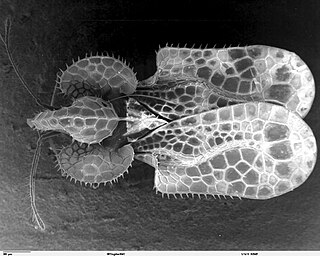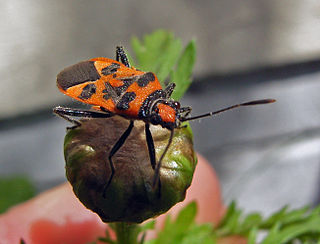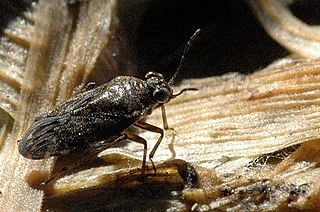
The Cimicomorpha are an infraorder of insects in the order Hemiptera, the true bugs. The rostrum and other morphology of all members apparently is adapted to feeding on animals as their prey or hosts. Members include bed bugs, bat bugs, assassin bugs, and pirate bugs.

Coreoidea is a superfamily of true bugs in the infraorder Pentatomomorpha which includes leaf-footed bugs and allies. There are more than 3,300 described species in Coreoidea.

A planthopper is any insect in the infraorder Fulgoromorpha, in the suborder Auchenorrhyncha, a group exceeding 12,500 described species worldwide. The name comes from their remarkable resemblance to leaves and other plants of their environment and that they often "hop" for quick transportation in a similar way to that of grasshoppers. However, planthoppers generally walk very slowly. Distributed worldwide, all members of this group are plant-feeders, though few are considered pests. The infraorder contains only a single superfamily, Fulgoroidea. Fulgoroids are most reliably distinguished from the other Auchenorrhyncha by two features; the bifurcate (Y-shaped) anal vein in the forewing, and the thickened, three-segmented antennae, with a generally round or egg-shaped second segment (pedicel) that bears a fine filamentous arista.

Pholcus is a genus of spiders of long-bodied cellar spider and allies in the family Pholcidae, with 375 described species as of January 2023.

The Ochteridae comprise a small family of insects. Eight genera with about 80 species have been described. They occur worldwide along the shore of various types of water and the greatest diversity is in tropical regions. They are "true bugs", being members of the order Hemiptera, and are in the suborder Heteroptera. Ochteridae commonly are known as the velvety shore bugs. They resemble the Saldidae shore bugs and have lengths ranging from 4.5 to 9 mm (0.18–0.35 in).

Saldidae, also known as shore bugs, are a family of insects in the order Hemiptera. They are oval-shaped and measure 2–8 mm (0.08–0.31 in) when mature. Typically they are found near shorelines or the marginal growths near freshwater bodies, estuaries, and sea coasts. They can flee by leaping or taking flight. There are about 350 recognized species with the majority from the Nearctic and Palearctic. Many species are found in the intertidal zone and both adults and nymphs of some species like Saldula pallipes can tolerate submergence at high-tide. Saldidae are predators and scavengers. They pass the winter through egg or adult diapause.

Vandopsis, abbreviated as Vdps in horticultural trade, is a genus of orchids in the family Orchidaceae. It contains ca. 5 species found in Southeast Asia, Southern China, the Philippines, and New Guinea. Recently Vandopsis undulata was excluded, as the genus would otherwise be paraphyletic. The species was transferred to the genus Cymbilabia.

Palaeontinidae, commonly known as giant cicadas, is an extinct family of cicadomorphs. They existed from the Late Triassic to the Early Cretaceous. The family contains around 30 to 40 genera and around a hundred species.

Justice Bao is a Chinese TV series starring producer Jin Chao-chun as the Song dynasty official Bao Zheng. The series ran for 3 seasons from 2010 to 2012. In addition to Jin, Kenny Ho, Fan Hung-hsuan and Lung Lung again reprise their iconic roles from the 1993 Taiwanese hit Justice Pao and the 2008 Chinese series Justice Bao.

ANA-12 is a selective, small-molecule non-competitive antagonist of TrkB, the main receptor of brain-derived neurotrophic factor (BDNF). The compound crosses the blood-brain-barrier and exerts central TrkB blockade, producing effects as early as 30 minutes and as long as 6 hours following intraperitoneal injection in mice. It blocks the neurotrophic actions of BDNF without compromising neuron survival.
R1SE was a Chinese idol boy band, formed by Tencent through the 2019 reality show Produce Camp 2019 on Tencent Video. The group consisted of 11 members: Zhou Zhennan, He Luoluo, Yan Xujia, Xia Zhiguang, Yao Chen, Zhai Xiaowen, Zhang Yanqi, Liu Ye, Ren Hao, Zhao Lei, Zhao Rang.
Burmese amber is fossil resin dating to the early Late Cretaceous Cenomanian age recovered from deposits in the Hukawng Valley of northern Myanmar. It is known for being one of the most diverse Cretaceous age amber paleobiotas, containing rich arthropod fossils, along with uncommon vertebrate fossils and even rare marine inclusions. A mostly complete list of all taxa described up until 2018 can be found in Ross 2018; its supplement Ross 2019b covers most of 2019.

Aneuretopsychidae is an extinct family of scorpionflies known from the Mesozoic. Fossils are known from the Jurassic (Callovian-Oxfordian) to the early Late Cretaceous (Cenomanian). It is part of Mesopsychoidea, a group of scorpionflies with siphonate proboscis. They are suggested to have been nectarivores, feeding off the liquid pollination drops of and acting as pollinators for now extinct insect pollinated gymnosperms such as Bennettitales.

Mimarachnidae is an extinct family of planthoppers known from the Cretaceous period. Their name is derived from spots on the wings of the first described genera, Mimarachne and Saltissus, being suggestive of spider mimicry, but these characters are not distinctive for the family as a whole. The family is characterised by "simplified venation and setigerous metatibial pecten and hind leg armature". as well as "rounded anterior margin of pronotum, double carination of pronotum and mesonotum"

Archijassidae is an extinct family of leafhoppers known from the Late Triassic to the early Late Cretaceous. It is the oldest member of Membracoidea, and is considered ancestral to modern leaf and treehoppers.
Yuripopovinidae is an extinct family of Coreoidea Hemipteran true bugs. Member species are known from the Early Cretaceous and early Late Cretaceous of Asia and northern Gondwana. Among the distinguishing characters are "the hemelytral costal vein apically much thickened and pterostigma-like, the corium with two large cells separated by one longitudinal straight vein." Dehiscensicoridae, described from the Yixian Formation of China has been deemed a junior synonym of Yuripopovinidae per Du et al. (2019). The family was named after Russian paleoentomologist Yuri Alexandrovich Popov.

Procercopidae is an extinct family of froghoppers. They are known from the Early Jurassic to early Late Cretaceous of Eurasia. They are one of two main families of Mesozoic froghoppers alongside Sinoalidae. Procercopidae are considered to be the ancestral group from which modern froghoppers are derived.
Perforissidae is an extinct family of planthoppers. They are considered to belong to the group of "Cixiidae-like" planthoppers. Species are known from the Early to Late Cretaceous of Eurasia, North America and South America. The family was named by Shcherbakov in 2007













